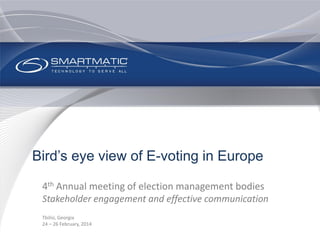Elections in Europe: A view on e-voting in Europe
- 1. Bird’s eye view of E-voting in Europe 4th Annual meeting of election management bodies Stakeholder engagement and effective communication Tbilisi, Georgia 24 – 26 February, 2014
- 2. Bird’s eye view on E-voting in Europe Where we are today and where we are heading? Matthijs Schippers VP Sales Western / Northern Europe Smartmatic International, Amsterdam
- 3. Electronic voting methods Electronic voting Polling station E-counting E-voting Remote voting Internet voting Tele voting
- 4. E-counting implementations Russia 2001: Pilots with ballot scanning 2004: BPC’s certified and used in 9,112 precincts in 32 subjects of the Russian federation 2010: BPC’s used in 798 precincts in 10 subjects of the Russian federation
- 5. E-counting implementations United Kingdom 2000: Precinct scanning for some districts for London Assembly and Mayoral elections 2004: Precinct scanning for some districts for London Assembly and Mayoral elections 2008: Central scanning for Greater London Assembly and Mayoral elections 2012: Central scanning for Greater London Assembly and Mayoral elections
- 6. E-counting implementations Scotland 2007: Nation wide use of regional e-counting centers for National parliament and local elections 2012: 31 regional e-counting centers for National parliament and local elections with new scanning systems
- 7. E-counting implementations Norway 2011: Central ballot scan center for local election Oslo
- 8. E-counting implementations Latvia 2011: E-counting for Parliamentary elections in 31% of all polling stations
- 9. E-voting implementations The Netherlands 1967: First implementation of mechanical voting machines 1978: First implementation of electro-mechanical voting machines 1992: First implementation of electronic voting machines (DRE’s) 2007: 95% of all municipalities vote with DRE’s
- 10. E-voting implementations Belgium 1992: First pilots in two municipalities 1994: First implementation of voting PC’s with monochrome CRT displays, light pen and magnetic swipe ballot tickets 2010: 2 certified types voting PC’s in use by 44% of all voters
- 11. E-voting implementations Germany 1975: First implementation of mechanical voting machines 1999: First implementation of electronic voting machines 2008: 5 states vote with 2 types of DRE’s
- 12. E-voting implementations Ireland 2001: First use in 1 county for the Nice referendum 2002: 1000 DRE’s used in 3 counties for General elections 2004: Central procurement of DRE’s for nation wide roll out
- 13. E-voting implementations France 2001: First pilots with DRE’s 2004: First implementation of 3 types of DRE’s for European elections 2007: 80 municipalities use DRE’s for Presidential and national parliamentary elections
- 14. E-voting implementations Russia 2005: First pilot with EVC’s 2007: First implementation of EVC’s in 21 precincts in 5 regions for parliamentary and presidential elections 2011: Use of EVC’s in 10 precincts in 1 Russian republic
- 15. E-voting pilots United Kingdom 2002: Pilots in Bolton, Stratford upon Avon, Chester, Liverpool Finland 2008: Pilots in 13 municipalities for local elections Italy 2006: Pilots in Cremona 2008: Pilots in Trentino
- 16. Where are we today? Ireland: Abandoned E-voting The Netherlands: Abandoned E-voting Germany: Abandoned E-voting France: Moratorium for new municipalities Finland : Discontinued E-voting pilots United Kingdom: Discontinued E-voting pilots Belgium: Renewed 70% & expanded 10%
- 17. Most important historical E-voting objectives The original goals for E-voting:  Fast results without counting errors;  Modern and high tech image;  Easier to find poll workers;  Elimination of spoiled votes and arbitrary ballot interpretation.  Technocratic implementation strategy
- 18. Implementation method Legal framework Certification framework System design & testing Roll out Stakeholder engagement and effective communication
- 19. Quo vadis? Does E-voting in Europe have a future? YES Intrinsic weaknesses of traditional voting have not disappeared:  Many spoiled ballots  Time consuming counting  Many counting errors  Considerable operational efforts  No accessibility for voters with special needs
- 20. Quo vadis? Does E-voting in Europe have a future? YES Initial signs of proof: • Belgium • The Netherlands
- 21. In conclusion Stakeholder engagement and effective communication are crucial to successful E-voting implementations After all: Democratic elected governments are of the people, by the people and for the people





















